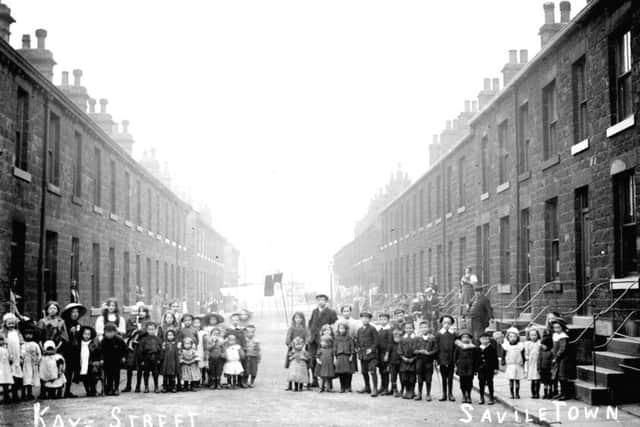The Nostalgia column with Margaret Watson – Savile Town


But whether they still live there or not, chances are most of them will still have a soft spot for the village of their childhood.
The gas man who comes to read my meter comes from Savile Town, and he loves to chat about it as he checks how much gas we’ve been using.
Advertisement
Hide AdAdvertisement
Hide AdThe first thing he asks me is what topic I‘m writing on this week and I sense he lives in the hope it will be about his beloved Savile Town.


Well, this week when he opens his Reporter he will be in for a pleasant surprise because it is all about Savile Town.
The culture of those now living there is different to those used to live in Savile Town, but the houses are still there, and so are the shops, although today they sell different commodities.
Indeed, it is one of the few villages which escaped the many slum clearance programmes going on in Dewsbury in the 1950s and 1960s.
Advertisement
Hide AdAdvertisement
Hide AdSome back-to-back houses, particularly those in Kaye Street, were demolished, but the majority which were stone built and sturdy still remain.
The biggest change, however, has been a cultural one because where there were once churches, there are now mosques.
The people who used to live in Savile Town started moving away in the 1950s and 1960s to live in the new council estates being built in Thornhill, Ravensthorpe and Chickenley.
Their old homes were bought by Asian immigrant families who settled in Savile Town in large numbers and made the village their own.
Advertisement
Hide AdAdvertisement
Hide AdBut former residents of Savile Town (like my gas man) still remember how wonderful it was to live in a village which had a strong community spirit and was just a short walk from the town centre.
They remember it as a much sought-after area where many of the well-to-do of Dewsbury once lived.
They remember how self sufficient it was and how they didn’t have to go into Dewsbury for anything, apart from entertainment, because everything else was right there on their doorstep.
I remember one former resident, the late Mrs Barbara Hill, who put her memories of Savile Town down in writing to give us a vivid picture of what it was like when she was a girl,
Advertisement
Hide AdAdvertisement
Hide AdBarbara lived in St Mary’s Place and later in Thornhill Street, Savile Town, until her marriage in 1956.
Her house in Thornhill Street was a two-up, two-down with a Yorkist Range in the kitchen and they also had an attic, but no bathroom.
The lavatory was at the bottom of the long back garden and a zinc bath was set in front of the kitchen fire on bath night.
She recalled how Savile Town was a close-knit community in the days when everyone knew each other and helped each other.
Advertisement
Hide AdAdvertisement
Hide AdShe wrote in her memoirs: “Neighbours used to pop into each other’s houses, borrowing cups of sugar or a jug of milk, or anything else that was needed in a hurry.
“There were lots of get-togethers, street parties and bonfire night parties.”
The corner shops of Barbara’s childhood were at the end of every street, and many still remain.
At one end of her street was the post office and at the other end, a fish shop. There were five other shops in the street, an off licence, newsagents and three grocers.
Advertisement
Hide AdAdvertisement
Hide AdIn South Street there was a greengrocer and hairdresser, and at the junction of South Street and Warren Street there was a Co-op.
Barbara loved to recall the street games children played – hop-scotch, whip and top, skipping, hide and seek, football and cricket, all played in the back streets.
But the children were safe because there were not many cars around, horse-drawn carts being the chief mode of transport for coal and milk.
The knife-grinder appeared on his bicycle with his grinding stone fixed to the front wheel, and he had to pedal away to make the stone turn so he could sharpen the knives and scissors people brought to him.
Advertisement
Hide AdAdvertisement
Hide AdBarbara recalled the war years and how they affected the people of Savile Town, like the government request for aluminium pans to help the war effort, and the evacuee children arriving from the cities which were being bombed.
She remembered them arriving at the Methodist Church in South Street, and how all the neighbours went to greet them.
Anderson shelters appeared in backyards, but Barbara’s family preferred to use their cellar when the air-raid sirens sounded.
One bomb dropped near Dewsbury Town Hall, and she never forgot the scene of destruction facing them when the “all clear” was sounded.
Advertisement
Hide AdAdvertisement
Hide AdShe recalled: “There was only rubble where once a family house had stood, and the loaves of bread the lady of the house had been baking were scattered in the street.
“She had just popped into a neighbour’s house while the bread was cooling, and this had saved her life.
“Another bomb had dropped a few streets away but luckily had only fallen on an allotment garden, leaving behind a small crater.”
There are many people reading this who will have similar memories of Savile Town but they have never written them down as Barbara did.
Advertisement
Hide AdAdvertisement
Hide AdThis is rich social history which must be preserved for future generations.
If you want to share your memories of childhood, or of the village where you once lived, please share them with readers send your memories via email to tresham [email protected]